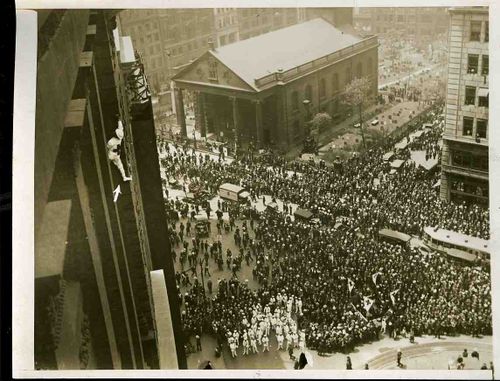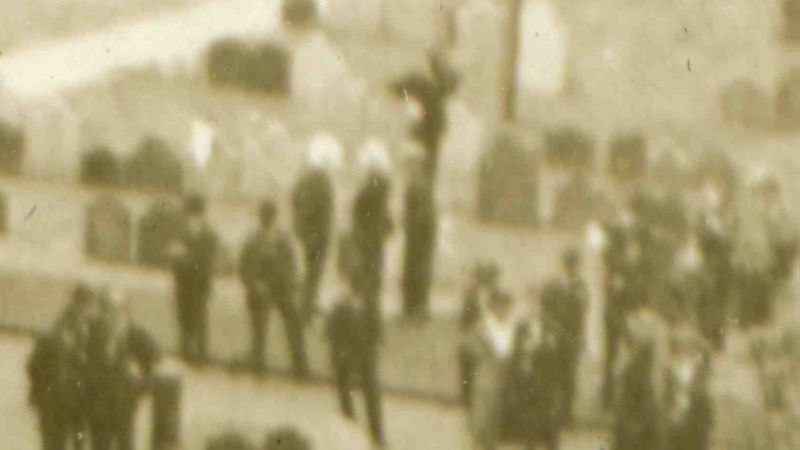JF Ptak Science Books LLC Post 433

Here's another in the Looking (Really) Closely at Prints series--actually they're more like a Inner Life of Prints series than anything, each mico-investigation leading to another entirely new world, each a new image, each a new view and vision, an orders-of-magnitude appreciation of one single object.
This photograph depicts a "human fly" making his untethered way up the side of a high rise in Manhattan (?), each foot of his success no doubt raising money for relief effort of American troops or displaced persons or orphaned children, probably in 1918.
Perhaps this is Mr. Harry G. Gardiner. the self-styled "human fly" who climbed many buildings in NYC and Boston and Philadelphia in 1918 and 1919. I cannot identify the church (Episcopal?) in the background, sorry to say (though I'm sure that this will be easy for someone to do). But I did have a very close and fairly thorough look at the crowd under some fair magnification, and found that not many were actually watching the climber. On the other hand how interesting can it be to watch someone climb a building--slowly--observing it from hundreds of feet away? I didn't see any kids, I don't think, and there are lots of people looking the other way. Its difficult not to try and put yourself in the very shoes of these people under the 'scope, trying to imagine what they were thinking, the heat of the sun on their boaters, the uncomfortable nature in general of wearing all of those clothes for the women, leaning against the black iron fence taking in the stubby sites of the graveyard next to the church....I stopped finally with the two guys in boaters (seen here in the enlargement, the original being just a specky bit at the rear of the cemetery at the back of the church, to the right), looking very comfortable and relaxed, one with his hands loosely clasped behind, the other perhaps pointing. Both are looking away from the climber, in the opposite direction, across the graveyard and above the gravestones. The sun caught their hats perfectly. They were enjoying a leisurely morning. There are hundreds and hundreds of these mico-scenes caught in this moment, their suggested fullness revealed only under magnification, like looking through a telescope, in a way, back into a frozen moment of time, yet another photonic jewel.




John--you can make up stuff all you want, but we may not get it if you don't, at least mostly, stick to English as it is commonly understood.
"Photonics" did not exist until the 1960's, so we can't ascribe it to photos 40 or more years earlier. Even if we try, it is not an accurate use of the word.
The good news is, if you continue usage of 'photonic' in this context, and if you can convince Jeff and only a few thousand others to do likewise, my criticism will become moot at some point.
It is a discussion my wife and I have fairly often: when does a new usage or word become accepted? She sometimes argues the French-government stance: It is not a new word until I say so! I argue the anarchist view that language is what we say it is, quite literally: we make it official by saying it.
Still, John, you need more support for "photonic" as you seek to use it than you have provided, and even Jeff's support might not be enough (he may see how the wind is blowing, here, and not even respond).
I am willing to sell my support, though, and it will not cost very much...maybe a cup of coffee next time I am in Asheville.
Posted by: Rick | 18 December 2008 at 11:18 AM
Well, Rick, I've given you all day to retract, but now I must point out that the Oxford English Dictionary cites the first use of the word "photonics" in 1952 in the Journal of the British Interplanetary Society. Of course, this revised date does not address your claim that a term can not properly apply to a past that predates the invention of the term. If this were so, we could not discuss the chemical and spectral properties of the pigments used by Michelangelo, or make countless other re-examinations of the past. But Michelangelo's pigments exist today, so we can deal with them directly in our own language. The same holds for John's photograph above. Now, you might object to the apparent misuse of the word "photonic" by assuming that John really meant "photographic," but in that photonics is the study of the application of the particle properties of light, one can make a case, especially given the grainy close-up in question, that John was referring exactly to the particle properties of the captured light. However, we don't have to stretch even that far, because the simple adjectival form "photonic" first appeared in 1938, a reference to light energy as photonic energy. In this regard, John's use of the phrase "photonic jewel" is almost poetic.
Posted by: Jeff | 18 December 2008 at 10:16 PM
Also, I have to say this. I think John knows full well that those distant "men" in boaters are aliens. John lived in D.C. and knows. This picture is exactly ten years after H.G. Wells warned us. This is the year that Wilson presented the 14 Points, and the Communist Party in Russia was formed. It's the year Joe DiMaggio was born AND Sunday baseball was legalized in D.C. Coincidence? Ha! The Red Baron was finally shot down ... do you think mere men accomplished that? Wilson authorized time zones and daylight savings time. I mean, it was all set up. The U.S.S. Cyclops disappeared in the Bermuda Triangle. Wilson said, “Only God and the Sea know where the great ship has gone.” Yeah, right. John knows who the men in boaters are, and he's very brave to put this sensitive information out there, no matter what his name might mean in Klingon. We wish him well.
Posted by: Jeff | 19 December 2008 at 10:05 AM
This is from John's Asssistant, the gorgeous Stompy Entwine. John was last seen being carried away, suspended by sausage strings and false hope, by a sub-miniature-but-visible fleet of pseudo/sub--alien boater podships, dragged not quite into the air for what he was saying was the "(eclipsed)rhino-tubed Wellsian pansperma in Lincoln, Nebraska" (the land of *outdated* photographs). So he cannot respond to today's comments, which is both fortunate and underfortunte. IF you're traveling west on I-26 over towards the Cumberland gap and you see him, tell him "Goober says 'Hey!' ". That is all.
Posted by: John F. Ptak | 19 December 2008 at 12:11 PM
Such a Lilliputian end to our fair friend, but Good and Just in scale, as he remains a Giant in our world, no matter where he has been carried. May the alien investigations be pleasant to him.
Posted by: Jeff | 19 December 2008 at 01:00 PM
Methinks there is a scarcity of oxygen in the hills of Colorado.
Posted by: patti digh | 19 December 2008 at 10:38 PM
"Dr. Stip Corpulentia calling in here answering the need for oxygen in Colorado. Did you know that I sold that "a" to the state of CO to get rid of a fourth "o"? True said that. Anyway I'm a optico-photonic specialist specializing in oxygen delivery to pseudo-high places AND a half-specialist in specious crickey stigmata vulgaris. I'm here to help."
Posted by: John F. Ptak | 19 December 2008 at 11:03 PM
Patti, yes, oxygen is low here, and although I remain pale, most people here are a ruddy sort. Let's just say it: We are redder blooded than the rest of America. My stepfather would have periodic bloodlettings to reduce his red blood cell count. True story. I must conclude that oxygen deprivation is not a factor in the posting of curious comments from lower altitudes. Something deeper is at work.
Posted by: Jeff | 20 December 2008 at 12:26 AM